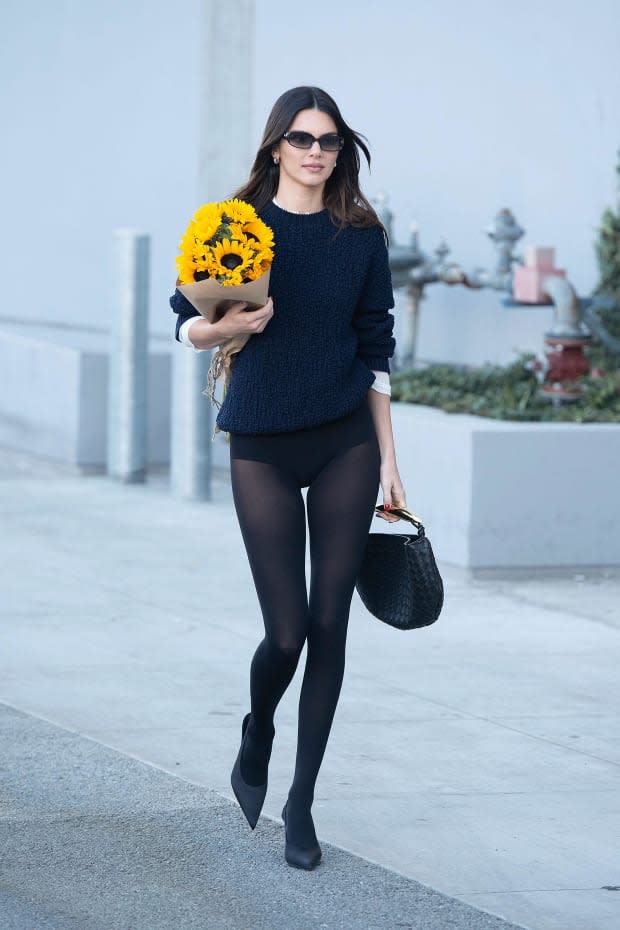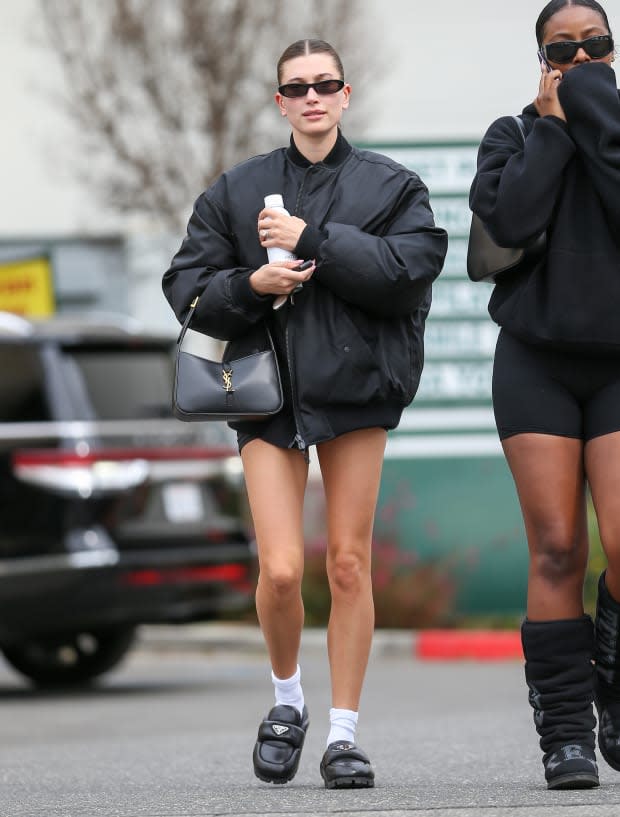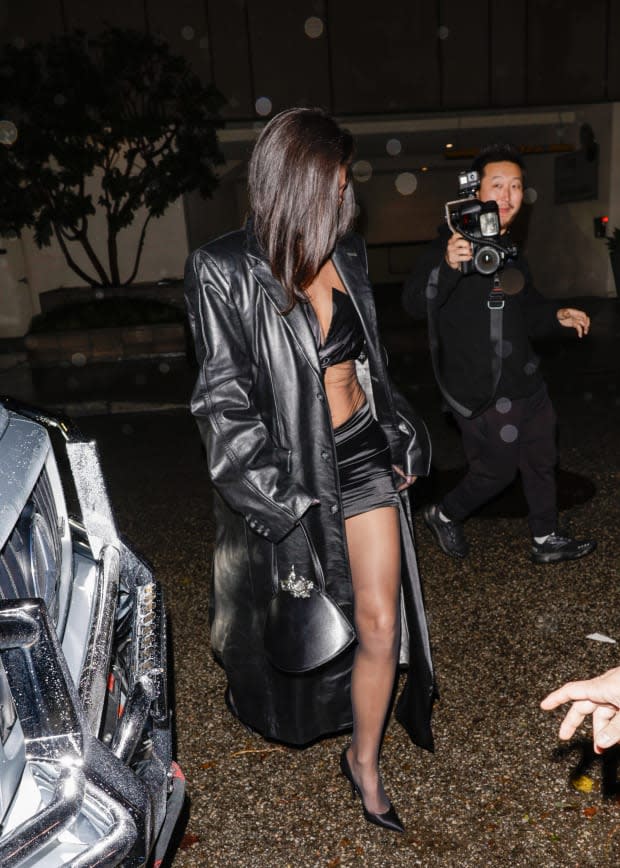Your Favorite Celebrity Street Style Photo Is Probably an #Ad
How "It" girls, publicists and paparazzi conspire to create these seemingly candid fashion moments.
Over the past decade, street style has evolved drastically. Between the rise of Instagram and its legions of influencers, and our constant demand for new celebrity content, what was once the domain of fashion editors, style bloggers and The Sartorialist, has become a content category more influential than the red carpet.
And thanks to the public's endless enthusiasm for these daily ensembles, combined with infinite opportunities for the rich and famous to "step out," fashion brands have also trained their attention on celebrities' daily pap strolls and how best to monetize them. More and more, the outfits of fashion plates like Kendall Jenner, Hailey Bieber, Bella Hadid and Addison Rae have become billboards for brands looking to use those ladies' tastemaker status to seamlessly insert their wares into the zeitgeist. By utilizing this strategy of IRL unmarked ads that are then sold back to the press as authentic, fashion labels have found a way to boost their bottom lines and digital footprints while creating seemingly organic street-style moments that will be disseminated across every platform. When in reality, that moment was pre-planned and, in many cases, completely bought and paid for.
Unbeknownst to consumers, million-dollar deals are taking place behind the scenes of their favorite street-style moments; these types of branded paparazzi setups have become one of the biggest open secrets in Hollywood. In fact, according to Jessica Carmona, a public relations manager at RK Communications, the majority of celebrity photos you're seeing out there likely feature some sort of paid placement from a brand.
"I'm just one person at one PR firm; there's a gazillion PR firms internationally. So imagine how many people are actually doing this on a daily basis with their clients that can afford it," she tells Fashionista. "I would love to be a normal consumer that knows absolutely nothing about what I do and then find out about it. I feel like my mind would be blown by just how much goes into getting that photograph that isn't just a photograph."
Pull PR founder Lexi Pulling agrees, adding that she's spoken with paparazzi who make their entire livelihoods exclusively off of these types of pre-arranged gigs. She explains, "A lot of it is paid and staged. And I feel like you can really tell it's one of those staged photos when it's well-curated — there's not people in the background, the girls have their makeup and hair done, they have the outfit on. I feel like that's a really good telltale sign of [a setup]."

Photo: Courtesy of Bottega Veneta
And in terms of who's engaging in this type of pay-for-play street style, paparazzo and founder of London Entertainment Group Giles Harrison says that it's largely influencers and model types. Although, if it's a Kardashian, specifically Kylie Jenner, he says, "It's all staged." (He also revealed that the reason that "very, very few guys do it" is because "nobody cares about men's fashion. Nobody's clicking on a hyperlink to his shoes.")
For Harrison, arranging one of these setups is often as simple as the celebrity's publicist, stylist, or occasionally the star themselves, calling him up and saying, "'I'm going to be here. I'm going to walk down this street.' It's not much more complicated than that." The celebrity does their walk, Harrison gets his shots, and then he sends them off to the celebrity's team for approval. The most difficult part of these situations, he says, is that, "you've just got to try and make sure you do it in a secluded place where nobody else is paying attention to you. The key to a setup is keeping it exclusive."
On the PR side of things, however, arranging the production of a single paparazzi image can often be a months-long process of research and negotiations. The goal is for the placement to read as authentic as possible to the casual observer. That's why most of the work is in "the strategy before going out," Carmona says.
She considers both which celebrities already fit organically into the aesthetic of the brand as well as "who the main consumer is, who this is going to appeal to, and [how to] make that moment really resonate and amplify across different channels." So after doing some research, she and the client create a short list of five to 10 famous people they will go out to with an offer. After approaching the celebrity's management, if they approve of the partnership, they will then move on to contractual negotiations. Once a deal is ironed out, the logistics of the paparazzi setup begin.
"That's the important part that consumers don't know about," the PR manager adds. "There have been multiple discussions about this," long before you ever see the final image on your iPhone screen. The research aspect of these deals is also particularly important, as the brand could be making a substantial investment in that person.
"We approached somebody for a campaign recently who is a top, very well known person. And for a campaign, that was a million dollars," Carmona explains. "They wouldn't even start talks with us for less than a million." But for these types of street style images, if you're going out to a group she calls the "seven heavy hitters," who guarantee you an almost instant return on your investment — Hailey Bieber, Gigi and Bella Hadid, Kendall Jenner, Kaia Gerber, Olivia Wilde and Emily Ratajkowski — expect to pay $500,000, at least.
Brands are more than willing to fork over millions for these types of "organic" placements because they can result in an immediate spike in sales. For example, while it was not a paid placement, one of Pulling's clients, Showpo, gifted Jennifer Lopez a top and pair of pants she wound up wearing during her wedding weekend. "She wore the full look and they got stories everywhere. They got Vogue, they got everything... [it's] the dream of any publicist to get the full look organically. And it sold out," she explained. Not only that, but it also created yet another viral moment in the aftermath when the brand's owner made a TikTok about the Lopez placement.
"When you can get that kind of exposure for your client, it can be really impactful on the bottom line and make them a lot of money," Pulling continues. It can also get the brand even more celebrity placements and name recognition. "People see other people wearing it and it influences the influential people."
"You see how many people are invested in the lives of celebrities, who either want to defend them until their dying breath or they want to look exactly like those girls and wear the same exact outfit," adds Carmona. "That's the appeal. The fan bases are so strong they will literally do anything that these girls do, wear what they wear, go to the same places they eat. They want a part of that lifestyle."
While these paid placements may seem slightly deceptive to the general public, Pulling counters, "It's beneficial for everyone. Everybody likes it. The talent likes it because they get to curate it and they get to make sure they look really great. The paparazzi are happy because they're gonna have a photo that they can sell. And even though it is curated, the consumer can still find it relatable."

Photo: Bellocqimages/Bauer-Griffin/GC Images
This escalating emphasis on the branding opportunities presented in stars' everyday outfits also seems to be hastening the death of the red carpet as the end-all, be-all of celebrity fashion.
"The everyday person is not walking a red carpet and wearing very dressy clothes," Pulling says. "I think it's just a more relatable image and look that people can recreate." Per Carmona, street style is "one of the strongest runways in terms of getting to the consumer." There's also far less competition for a smaller or non-luxury brand to get noticed.
"As a fashion publicist, it's a lot harder to place a red carpet look on a celebrity because you're competing with Louis Vuitton and Dior and all these huge brands," Pulling explains. "When you're doing a staged paparazzi shoot, the more accessible fashion brands really have an opportunity to be able to shine and get that same sort of press coverage." That's especially true when you consider how many celebrities are stepping out multiple times a day in multiple different looks. With the potential for outfit changes and money to be made in street style, it's no wonder photographer Harrison thinks, "The step-and-repeat red carpet is boring as shit."
These types of setups also allow brands to skip the middlemen of traditional media and target their customer right where they live — their social media feeds, where these images often proliferate. When it comes to figuring out "what the new dress that I have to wear is, they're doing that mainly from social media," says Carmona. "It resonates so much more. No one's reading Vogue." Especially not Gen Z — a generation brands are increasingly eager to reach.
"They know that the [Gen Z and millennial] consumer is a lot smarter with their dollar, they're not just going to spend to spend," adds Carmona. "They know that they can't afford what's happening on the runway. So with something that's attainable, I think the mass consumer is like, okay, I get to at least cosplay this lifestyle." Pulling admits that even she has fallen victim to this social media shopping mentality, explaining, "I know if Hailey Bieber wears something, that's going to be cool and people are going to like it. So it makes my life easier. I just look at her Instagram and I'm like, 'okay, I'll get that, that, that,' and I'm good to go."
Plus, brands know that by going straight to the consumer in this way, they'll still get media coverage, via digital publications who consistently cover celebrities and link out to what they wear. "They're getting the amplification of the fact that everybody wants to cover Kendall Jenner, for example. That's how they're getting their clicks to the Just Jareds, their clicks to the Who What Wears, because they know that they're making sales," Carmona says.
That said, these types of arrangements aren't always a sure thing, especially when the talent is someone with less proven selling power. As top earners continue raking in six and seven figures on these outings, there are also unpaid up-and-comers who might aspire to get there and appeal to brands with smaller budgets.
"Some girls are really just interested in getting their name out there and it's not a paid thing. They want the exposure," says Pulling. She'll will work with them to put together outfits composed out of the brands she represents and then they'll either go somewhere where they're guaranteed to get papped, like Nobu or Craig's, or she'll call up one of the paparazzi they work with that has "really great connections to media outlets" to make sure that the moment is documented and disseminated to the press. This is also a great option for stars who "are trying to show themselves as more of a fashion person and want to gain traction in the fashion community," Pulling adds.
Harrison has also arranged these types of setups with no-name influencers before, but he points out that there's got to be something in it for him.
"I can't tell you the amount of people that call me up and want to be photographed and, pardon my French, they're fucking nobodies," the photographer says. "But they're doing it because they're trying to land a bigger deal, or they're trying to get more popular." And while he's open to building relationships with these types of ingenues, he admits it usually isn't beneficial to him financially. But depending on his mood that day, he'll still go out and photograph them occasionally for the "long game."
"If they like your photos, maybe they call you later on when they're doing something really interesting," he explains. "Like if 10 years ago, Austin Butler was saying, 'Oh, come follow me around and take photos of me,' and I did it, I'd be waiting until now before anyone would care. Because when he was with Vanessa Hudgens by himself, nobody gave a shit. I mean, seriously, couldn't give him away." Waiting that long for an ROI on a celebrity is simply bad business for a paparazzo.

Photo: Rachpoot/Bauer-Griffin/GC Images
When it comes to branded street-style moments, another issue is the barrier to entry for smaller, up-and-coming labels who don't necessarily have the budget to secure big-name celebrity placements.
"It's really unfortunate because we have such talented young creatives that really have to fight to even be seen in the media landscape because they don't have that funding to pay a Kendall." On top of that, they "likely aren't being stocked in places that have really good affiliate programs," which can often be the deciding factor for media outlets that make revenue off of hyperlinking shoppable celebrity outfits.
"How do we give them a chance?" she asks. "Everything's so money motivated. It's going to be a much tougher landscape to navigate."
As with any emerging marketing tactic, there's also the question of if and when consumers will catch on. "I mean, with social media and TikTok, it feels like everybody can learn and figure it out," Pulling argues. On the other hand, Harrison feels the general public is still totally clueless: "I think people still think, 'Ooo, they caught them out in the wild,'" he says. Carmona agrees that the consumer is "entirely unaware."
And for brands who might be trying skirt the #ad disclosures required for, say, brand-sponsored Instagram content, there's the question of whether or not the Federal Trade Commission (FTC) will come for these quietly sponsored paparazzi arrangements. Carmona points to the recent crackdowns on social-media disclosures by the FTC, as well as in the UK and Germany.
"There needs to be truth in advertising," she says, although she's unsure exactly what that would look like in this case. Considering all of the loopholes that already exist in terms of gifting and product reviews, Carmona admits, "I don't know how that's ever going to be regulated to the point where the consumer's going to know that this is a hashtag-ad." For now, the best solution may be education and discussing these things more openly. "The public needs to be a lot more media literate."
Never miss the latest fashion industry news. Sign up for the Fashionista daily newsletter.

